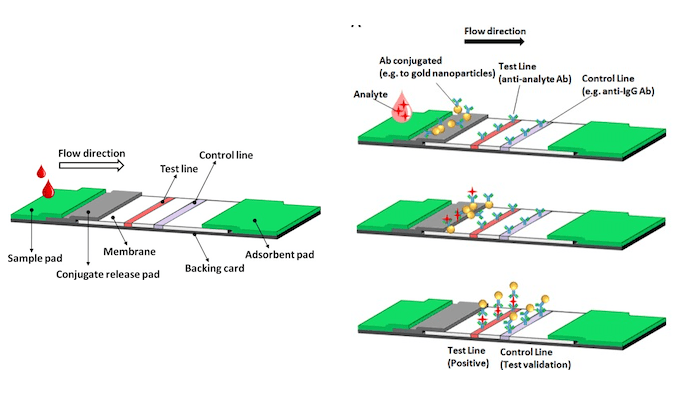
Incorrect: Oral drug tests are intended for human saliva samples, not food or beverage. Using drug tests on energy drinks is a misuse of the tests that can result in false positives and makes the results invalid.

FULL CLAIM: “Red Bull's got a positive on buprenorphine, which is a toxin, and cocaine. So that's what we're putting in our bodies when we drink Red Bull”
REVIEW
In November 2023, a TikTok video with more than 13 million views claimed that an energy drink contained illicit drugs. Clips of the video also circulated on Facebook, where they received over 300,000 views.
The video showed two people using a saliva drug test on liquid poured from a can of Red Bull, a popular energy drink. The test showed a positive result for the stimulant cocaine and for buprenorphine, a synthetic opioid used to treat opioid dependency. The voices in the video then claimed, “So that’s what we’re putting in our bodies when we drink Red Bull”, implying that the beverage contained these two drugs.
In 2019 and 2020, Snopes and USA Today debunked similar videos claiming that Red Bull and another energy drink called Bang tested positive for various drugs, including methamphetamine, oxycodone, buprenorphine, and ecstasy using a drug urine test.
However, energy drinks don’t contain any of the substances mentioned in these videos. The list of ingredients is clearly visible on the product’s label and includes carbonated water, sugars, vitamins, minerals, caffeine, taurine, citric acid, baking soda, sweeteners, flavors, and colors. A nutrient profile elaborated by the FoodData Central website from the U.S. Department of Agriculture confirms this list of ingredients. This profile is based on the National Nutrient Database for Standard Reference, Legacy, which includes historical data on food components derived from analyses, calculations based on other nutrients, and published literature.
What these videos actually showed is a misuse of drug tests, which are intended for human biological samples such as saliva and urine, not food or beverage. The tests weren’t developed to be used on energy drinks, therefore the results obtained with these samples are unreliable and cannot be taken as evidence that drugs are present in these beverages.
How do drug tests work?
The test used in the video is the T-Square® Oral Fluid Saliva Drug Test Kit. This type of drug test is a simple, quick, and low-cost method for simultaneously detecting the presence of several drugs of abuse—including illicit drugs and prescription medicines—in a person’s saliva.
These tests are based on a technology called lateral flow immunoassay that uses antibodies that can bind specifically to the substance of interest. The antibodies are also attached to a molecule that can produce color. When the substance of interest is present in the sample, the antibodies bind to it, producing a color signal that is easy to read and interpret[1].The same principle is also applied to many other home test kits, including home pregnancy tests and rapid SARS-CoV-2 tests.
Figure 1 shows how the procedure works.

Figure 1 – Schematic representation of the lateral flow immunoassay test strip components (left). Mechanism of action of a lateral flow immunoassay direct test (right). The sample, placed on one end of the strip (up), moves into the conjugated release pad containing the antibodies attached to a label (middle). The sample bound to the conjugated antibodies then moves towards the test line, which contains antibodies that are also specific for the substance of interest. This allows a color reaction to take place, producing a color band in the test line (bottom). Source: Koczula and Gallotta[1].
First, the sample is applied to one end (sample pad) of a strip. This pad usually contains a solution that helps stabilize the sample and adjust its chemical properties, such as acidity and viscosity.
Next, the sample enters a zone (conjugate release pad) where it mixes with antibodies that are attached (conjugated) to color particles.
This mixture of sample and conjugated antibodies enters the detection zone. The “test” line in the detection zone contains antibodies that also recognize and bind specifically to the substance of interest. When a drug is present in the sample, it binds to the antibodies in the conjugate release pad and those in the test line, causing an interaction between both that produces a color signal.
The “control” line in the detection zone contains antibodies that bind to free antibodies from the earlier conjugate release pad. The “control” line tells us whether there was adequate liquid flow through the strip and is a quality control marker for the test.
Oral fluid drug tests are intended for human saliva samples, not food and beverages
Home drug tests allow rapid detection of one or more drugs of abuse in a variety of human samples, including saliva, urine, blood, and other fluids. These tests are reasonably sensitive and reliable, but only when they are conducted properly and following the manufacturer’s instructions. This isn’t the case in the video.
First and foremost, using an oral drug test on a beverage is incorrect because these tests are designed for human saliva samples. Saliva has a composition, pH, and general properties that differ significantly from those of food and beverages. For example, the American Dental Association explains that oral pH typically ranges between 6.5 and 7.8 (from slightly acidic to slightly alkaline). In contrast, Red Bull has a very acidic pH, around 3.3, which might alter or damage the strip or the antibodies, rendering the results unreliable.
This isn’t the first time this type of test has been misused to support false claims. In December 2020, Health Feedback reviewed another video in which Michael Schnedlitz, a member of the National Council of Austria, showed at the Austrian parliament how Coca-Cola tested positive on a rapid SARS-CoV-2 antigen test. Schnedlitz interpreted this result as proof that rapid antigen tests were useless. However, the result of this test is invalid for the same reasons discussed above.
Even when these tests are conducted correctly, the U.S. Food and Drug Administration notes that what the person eats or drinks before taking the test may affect the accuracy of the results.
For example, food and drinks can contain ingredients that cross-react with the antibodies in the test. This can typically occur with molecules that have a similar structure to the substances screened for in the test, as Peter Chai, a toxicologist at Brigham and Women’s Hospital in Boston, told USA Today. The result is a false positive in people who consumed the drink. For this reason, the manufacturer of the saliva drug test recommends that people “avoid placing anything in the mouth 10 minutes prior to testing”.
Owing to these and other limitations, these tests can only offer presumptive results, that is, preliminary results that require further confirmation using a laboratory test. This information is clearly stated in the test’s package insert.
Conclusion
Claims that energy drinks contain cocaine and other drugs of abuse are based on an incorrect use of the test on samples for which the test isn’t designed. Therefore, a positive result from these tests isn’t evidence that the beverage contains illicit drugs. Instead, it illustrates how misusing the test can produce false positives.
REFERENCES
- 1 – Koczula and Gallotta (2016). Lateral Flow Assays. Essays in Biochemistry


